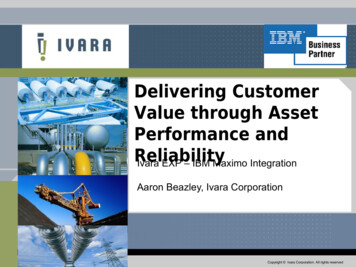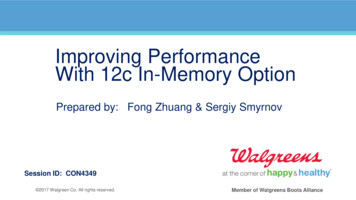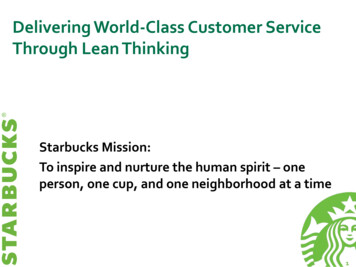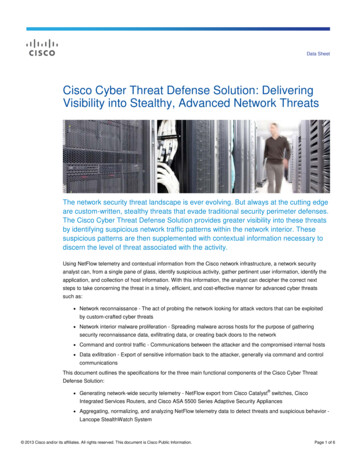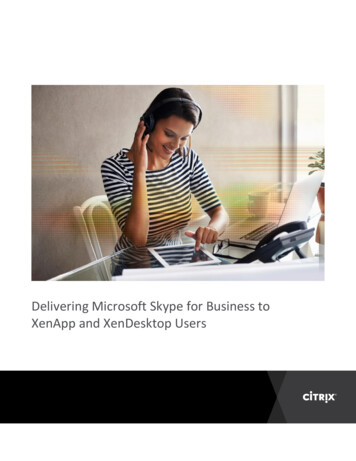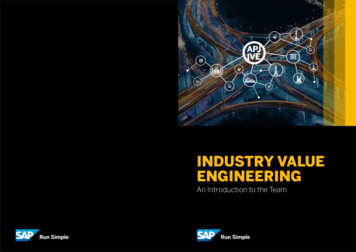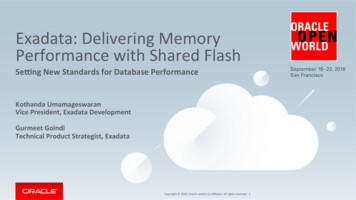
Transcription
Exadata: Delivering MemoryPerformance with Shared FlashSe#ng New Standards for Database PerformanceKothanda UmamageswaranVice President, Exadata DevelopmentGurmeet GoindiTechnical Product Strategist, ExadataCopyright 2016, Oracle and/or its affiliates. All rights reserved.
Safe Harbor StatementThe following is intended to outline our general product direcNon. It is intended forinformaNon purposes only, and may not be incorporated into any contract. It is not acommitment to deliver any material, code, or funcNonality, and should not be relied uponin making purchasing decisions. The development, release, and Nming of any features orfuncNonality described for Oracle’s products remains at the sole discreNon of Oracle.Copyright 2016, Oracle and/or its affiliates. All rights reserved. Oracle ConfidenNal – Internal/Restricted/Highly Restricted2
Announcing Oracle Database 12c Release 2 on Oracle Cloud Available now– Exadata Express Cloud Service Coming soon– Database Cloud Services– Exadata Cloud MachineOracle is presenNng features for Oracle Database 12c Release 2 on Oracle Cloud. We will announce availabilityof the On-Prem release someNme aXer Open World.Copyright 2016, Oracle and/or its affiliates. All rights reserved. 3
Did You Miss the Storage RevoluNon? Incumbent storage vendors have decadesold investment in legacy protocols keepingthem from adopNng new technologies PCIe Flash with NVMe interface is a newinterface that realizes full flash potenNal PCIe/NVMe storage architectures areorders of magnitude faster than what youprobably use today Available now with Oracle Exadata storageStorage PerformanceGood Chance Your Storage Vendor Did TooStorageVendorsPCIeNVMeSCSISASConvenIonalStorage EraCopyright 2016, Oracle and/or its affiliates. All rights reserved. 2014Modern Flash Era
Solid State Media is Very Different Than Spinning Disk Compared to Spinning Disk, Flash– Is many orders of magnitude faster– Has many orders of magnitude higher bandwidth– Has extremely low latency– Has wearing issues as it ages, but technology is catching up– Is expensive, but the price gap is shrinking Every storage vendor has some flash based soluNon for your DatabaseQ: Will my database realize the full benefit of flash technology ?A: It will depend on how fast you can move the data from the flash to the databaseCopyright 2016, Oracle and/or its affiliates. All rights reserved. 5
SCSI Access Model SCSI was designed for tapes and HDDs HDDs are sequenNal whereas Flashdevices are massively parallel TradiNonal IO stack is opNmized forspinning media– 512 Byte block size transfers– Flash and databases do 4KB/8KB IOsCPU8 KB IO Using legacy interfaces like SCSIfundamentally boglenecks flash drivesCopyright 2016, Oracle and/or its affiliates. All rights reserved. HBA SCSI512 B512 B4 KB IO512 BSCSI6
PCI Express Vs SAS ConnecNvity PCI Express is orders of magnitude fasterthan SAS, and is gehng faster PCI Express has the same characterisNcsas Flash8PCIe has 13xthroughput of SAS4– High Throughput– Low Latency Using legacy interconnects like SASfundamentally boglenecks flash drives0.6SAS 6 Gbps1.2SAS 12 GbpsPCIe 3.0 x4PCIe 3.0 x8Througput GB/sCopyright 2016, Oracle and/or its affiliates. All rights reserved. 7
PCI Express Flash with NVMe Interface Non VolaNle Memory Express is abrand new grounds up interfacedesigned for flash NVMe is inherently parallelCPU NVMe provides naNve atomic IO sizeaffinity for databases NVMe IO stack massively reduces CPUuNlizaNon and latencyPCIe NVMeNVMe is 2.2x2.2xFaster than SCSIPCI Express Flash with NVMe Interface is the right choice for your DatabaseCopyright 2016, Oracle and/or its affiliates. All rights reserved. 8
Exadata is Leading NVMe AdopNonThousands of Exadata systems shipped with NVMe Flash since 20141stFacebook launchesLightning based onNVMeExadata X5-2Industry’s Frist EnterpriseSystem with NVMeNVMe Drive bySamsung201520141stNVMe Drive byIntel2016Exadata Cloud Serviceuses NVMe in PublicCloudExadata X6-2Second GeneraNonwith NVMeQ1EMC Announces DSSDD5 with NVMeCopyright 2016, Oracle and/or its affiliates. All rights reserved. 9
Shared Storage Has Many Advantages over Local StorageServers Much beger space uIlizaIon Much beger security, management, reliabilitySAN/LAN Enables DB consolidaIon, DB high availability,RAC scale-out Shares storage performance– Aggregate performance of shared storage can be dynamicallyused by any server that needs itShared StorageCopyright 2016, Oracle and/or its affiliates. All rights reserved. 10
New Exadata X6 Super-Capacity and Performance Flash 3D V-NAND 3.2TB/card (2X previous card capacity)– 48 layer NAND– No tradeoffs - faster writes, lower power, higher endurance Latest, most modern interface – NVMe (introduced in X5) Fastest flash card on market by wide margin– Only flash card on market with PCI 8-lane scale bandwidth 5.4GB/sec– Highest IOs per second– Lowest outliers – 99.995% write IOs complete within 250usCopyright 2016, Oracle and/or its affiliates. All rights reserved. 11
NVMe PCI-e Flash Disrupts the Storage Array ModelNew improvements are causing 100X bo lenecks across shared storage stackSAN Link 40Gb5 GB/secLess than 1 Flash cardLatest PCIe Flash5.4 GB/secLeading All Flash Array24 GB/secLess than 5 Flash cardAll-Flash Storage Array IO Path: many steps, each adds latency and creates bo lenecksArrayHeadsSSDCtrlFlash opyright 2016, Oracle and/or its affiliates. All rights reserved. Oracle ConfidenNal – Highly Restricted12
Only Exadata Achieves Full Performance of Shared Flash500 Leading All-Flash Storage Arrays achieveunder 3% of potenIal flash throughputWasted Flash PotenIal300100Actual Throughput200Wasted Flash PotenIal400Pure StorageLargestActual Throughput– 132 MB/sec per flash drive– 120 MB/sec per flash drive Spinning disk level throughput! AND can’t scale-out for higher performance AND can’t share even this slow performance dueto bogleneck at server inputs Exadata X6 achieves full flash throughput 5400 MB/sec per drive0Exadata SingleRack Pure Storage EMC XtremIOEMC XtremeIO4-brickPotenIal Throughput* Exadata also achieves much faster OLTPIOs 5.6 Million IOPs, 250us latency even at 2.4M IOsCopyright 2016, Oracle and/or its affiliates. All rights reserved.*PotenNal Throughput based on number of flash devices 13
Exadata Achieves Memory Performance with Shared FlashExadataDB Servers Exadata X6 delivers 300GB/sec flash bandwidth to anyserver– Approaches 800GB/sec aggregate DRAM bandwidth of DB serversInfiniBandQueryOffload Must move compute to data to achieve full flash potenIal– Requires owning full stack, can’t be solved in storage alone Fundamentally, Storage Arrays can share flash capacity butnot flash performanceExadata Smart StorageFlashChipsPCIe NVMeCPU– Even with next gen scale-out, PCIe networks, or NVMe over fabric– E.g. new EMC DSSD has 3-6 Imes slower throughput than Exadata X6 Shared storage with memory level bandwidth is a paradigmchange in the industry– Get near DRAM throughput, with the capacity of shared flashCopyright 2016, Oracle and/or its affiliates. All rights reserved. 14
Exadata X6 I/O is Much Faster than All-Flash EMCOLTP Write IOPSAnalyIc Scans3505.2 M52.5X301300GB/sec One High Capacity Exadatabeats the fastest EMCXtremIO all-flash array inevery performance metric– 12X more throughput– 2.5X more IOPS– 2X faster latency12X2504320015022M1005001248 X-Brick EMCXtremIO1 Rack HCExadata08 X-Brick EMCXtremIO1 Rack HCExadataEMC Performance does not scale higher - Exadata scales by adding racksCopyright 2016, Oracle and/or its affiliates. All rights reserved. 15
Exadata X6 I/O is Much Faster than All-Flash Pure StorageOLTP Write IOPSAnalyIc Scans35033X4320015021.2 M10004X301250505.2 M5300GB/sec One High Capacity Exadatabeats the fastest PureStorage all-flash array inevery performance metric– 33X more throughput– 4X more IOPS– 4X faster latency19PureStorage //M701 Rack HCExadata0Pure Storage //M701 Rack HCExadataAxisTitlePure Storagedoesnot scale higher - Exadata scales by adding racksCopyright 2016, Oracle and/or its affiliates. All rights reserved. 16
Gehng Memory performance with SharedFlash using Smart SoXwareCopyright 2016, Oracle and/or its affiliates. All rights reserved. 17
Oracle’s Infrastructure InnovaNons in Flash Oracle Exadata V2: First to bring flash storage to the database market Oracle Exadata X3: Doubled flash capacity Oracle Exadata X4: 100GB/s throughput scans in a single rack Oracle Exadata X5: Lowest latency NVMe and increases scans to 263GB/s Oracle Exadata X5: Hot-pluggable NVMe server for the database Oracle Linux: First Linux vendor with producNon NVMe drivers Oracle Exadata X6: Highest throughput over 350GB/s and lowest latencyCopyright 2016, Oracle and/or its affiliates. All rights reserved. 18
Oracle’s SoXware InnovaNons in Flash Exadata Smart Flash Cache Exadata Smart Flash Log Exadata Smart Flash Cache Scan Awareness Exadata Smart File IniNalizaNon Exadata Smart Columnar Flash Cache Exadata Smart Flash Cache Space Resource Management Upcoming: Exadata Smart In Memory Formats in Flash Upcoming: Smart write burst and temp IO in Flash CacheCopyright 2016, Oracle and/or its affiliates. All rights reserved. 19
Exadata Smart Flash Cache12 TBDRAMHo est Data Understands different types of I/Os from database– Skips caching I/Os to backups, data pump I/O, archive logs, tablespace formahng– Caches Control File Reads and Writes, file headers, data and index blocks– Enables more space for relevant user data180 TBPCI FLASHAcIve Data Immediately adapts to changing workloads Write-back flash cache– Caches writes from the database not just reads Doesn’t need to mirror in flash for read intensive workloadsCold Data1.3 PBDISK– Flash arrays store both mirror copies always in flash increasing your cost Smart Scans can run at the throughput of flash drives– Flash arrays need lots of servers with lots of processes and sNll cannot match Smart Scanthroughput of single query Provides performance of flash at cost of diskCopyright 2016, Oracle and/or its affiliates. All rights reserved. 20
Exadata Smart Flash Log Outliers in log IO slow down lots of clients Outliers from any one copy of mirror slow down allthe foregrounds– Database wait Nme goes up by #foregrounds * Stall Nme– Backlog doesn’t clear immediately like an accident on thefreeway and increases “log file sync” waitsLog WriterforegroundclientLog Buffer Performance criNcal algorithms like spacemanagement and index splits are sensiNve to logwrite latencyforeground Legacy storage IO cannot differenNate redo log IOfrom othersclientforegroundclient UPS protected cache in tradiNonal storage seems towork iniNally unNl the cache is overwhelmed by otherwrites– Measure log file latency with full backup or a data loadrunningCopyright 2016, Oracle and/or its affiliates. All rights reserved. 21
Exadata Smart Flash LogSmart Logging - OffSmart Logging - On Smart Flash Log uses flash as a parallel write cache todisk controller cache Whichever write completes first wins (disk or flash) Reduces response Nme and outliers– “log file parallel write” histogram improves– Greatly improves “log file sync”No Outliers Uses almost no flash capacity ( 0.1%) Network resource management provides priority forredo log I/Os across the network OLTP workloads transparently accelerated andprovide predictable response NmesCopyright 2016, Oracle and/or its affiliates. All rights reserved. 22
Exadata Smart Flash Cache Scan Awareness On a tradiNonal cache, if you scan dataset larger thancache size– Blocks 0,1,2,3 brought into cache, cache is full– Scanning Blocks 20,21,22,23 replaces 0,1,2,3 in cacheCACHEHOT Repeat the same scanInsert new block– Block 0,1, 2, 3 will replace blocks 20,21,22,23– Block 20,21,22,23 will again replace block 0,1,2,3 TradiNonal caches churn with no actual benefit Some implementaNons call the inserNon of new blockin the middle scan resistantChurnCOLDCopyright 2016, Oracle and/or its affiliates. All rights reserved. 23
Exadata Smart Flash Cache Scan Awareness Exadata Smart Flash Cache is scan resistant– Ability to bring subset of the data into cache and not churn– OLTP and DW scan blocks can co-existCACHEHOT Nested scans bring in repeated accesses– Repeat, For each item in large table, scan small table– Smart enough to pull the small table into flash since it is accessedrepeatedly even though the size of large table alone is larger thanflash cache No need to set “KEEP” agribute in data warehouses Scans automaNcally use flash for extreme performance Scans won’t blow out the cache providing predictable OLTPperformanceCopyright 2016, Oracle and/or its affiliates. All rights reserved. COLD24
Exadata Smart File IniNalizaNon Combine the benefits of Smart IniNalizaNon and Writeback FlashCache– Write file creaNon meta-data to writeback flash cache– Tiny amount of flash space used to cache large porNons of iniNalized dataon disk– IniNalizaNon I/Os to disk deferred or not performed if data loaded Create tablespace, file extensions, autoextend show benefit Redo log iniNalizaNon included in Exadata 12.1.1.1.0 File creaNon sped up by over 10xDatabaseMetadataStorage CellMetadataFlashDisksCopyright 2016, Oracle and/or its affiliates. All rights reserved. 25
Exadata Smart Columnar Flash Cache Hybrid Columnar Compression balances need for OLTPand AnalyNcsselect columnA fromtable where As CPUs get faster want even faster scans Smart Flash Cache automaNcally transforms blocksfrom hybrid columnar to pure columnar for analyNcsduring flashcache populaNonFlash Cache PopulaNon Dual format representaNon for single row lookups Only selected columns read from flash during a query Up to 5x query speedupCompression UnitsCopyright 2016, Oracle and/or its affiliates. All rights reserved. Columns26
Smart Flash Cache Space Resource Management Flash Cache is a shared resource Database as a Service creates need for efficient resource sharingFINANCE Specify minimum (flashCacheMin) and maximum (flashCacheLimit) sizes, or fixedallocaNons (flashCacheSize), a database can use in the flash cacheALTER IORMPLANSALES-dbplan ((name sales,flashCacheSize 100G), -(name finance,flashCacheLimit 100G, flashCacheMin 20G), (name schain, flashCacheSize 200G)) Container database resource specified at the storageSUPPLYCHAIN Pluggable database container resource limits expressed as percentages in the containerdatabase Database and Pluggable database I/O resource management is unique to Exadata Predictable performance for database queries – no more noisy neighborCopyright 2016, Oracle and/or its affiliates. All rights reserved. 27
Upcoming: In memory format in Columnar Flash Cache In-Memory formats used in Smart Columnar Flash Cache Enables vector processing on storage server during smart scans– MulNple column values evaluated in single instrucNonIn-MemoryColumnar scans Faster decompression speed than Hybrid Columnar Compression Enables dicNonary lookup and avoids processing unnecessary rows Smart Scan results sent back to database in In Memory Columnarformat– Reduces Database node CPU uNlizaNonIn-FlashColumnar scans In-memory performance seamlessly extended from DB node DRAMmemory to 10x capacity flash in storage– Even bigger differenNaNon against all-flash arrays and other in-memorydatabasesUpcoming release of Exadata So6wareCopyright 2016, Oracle and/or its affiliates. All rights reserved. 28
Upcoming: Smart write bursts and temp IO in flash cache Write throughput of four flash cards has become greater than thewrite throughput of 12-disks When database write throughput exceeds the throughput of disks,smart flash cache intelligently caches writesWrite Burts and Temp IOinFlash Cache– Schema changes during applicaNon upgrades rewrite enNre tables in somepackaged applicaNons– Large database consolidaNons can have write bursts at the same Nme When queries write a lot of temp IO and it is boglenecked on disk,smart flash cache intelligently caches temp IO– Writes to flash for temp spill reduces elapsed Nme– Reads from flash for temp reduces elapsed Nme further Smart to prioriNze OLTP data and does not remove hot OLTP linesfrom the cache Smart flash wear management for large writes Much faster scans and disk writesUpcoming release of Exadata So6wareCopyright 2016, Oracle and/or its affiliates. All rights reserved. 29
Preview: Non-volaNle Memory Tier in Exadata StorageComputeServer Exadata Storage Servers will add a non-volaNle memory(NVRAM) cache in front of Flash memoryStorageServerNVRAMHotWarmRDMA– Similar to current Flash cache in front of disk– RDMA direct access to NVRAM gives 20x lower latency than Flash NVRAM used as a cache effecNvely increases its capacity by 10x Expensive NVRAM shared across servers for lower cost NVRAM mirrored across storage servers for fault-toleranceColdCopyright 2016, Oracle and/or its affiliates. All rights reserved. 30
Exadata Smart Flash Benefits Smart Flash Cache is database aware Smart Flash Logging avoids redo log outliers Smart Flash Cache Scan provides subset scanning and is table scan resistant Smart File IniNalizaNon creates a file by wriNng meta-data to flash cache Smart Columnar Flash Cache extends columnar benefit to storage Smart Flash Cache Space Resource Management provides granular control Upcoming: Smart Flash cache with in memory formats enables massivecapacity for vector processing Upcoming: Smart write burst and temp IO in Flash CacheCopyright 2016, Oracle and/or its affiliates. All rights reserved. 31
Copyright 2016, Oracle and/or its affiliates. All rights reserved. 32
Exadata X6 I/O is Much Faster than All-Flash Pure Storage One High Capacity Exadata beats the fastest Pure Storage all-flash array in every performance metric – 33X more throughput – 4X more IOPS – 4X faster latency 16 9 301 0 50 100 150 200 250 300 350 Pure Storage //M70 1 Rack HC Exadata Axis Title sec 33X AnalyIc Scans 0 1 2
